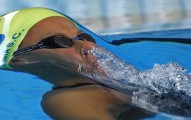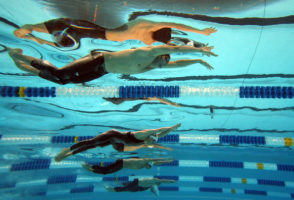 At Eurosport, the European Swimming Championships (more precisely, in water sports) are in full swing now. Looking with one eye (working) at what is happening on the screen, I involuntarily became interested in some questions (why do swimmers-athletes need wetsuits, do they shave their legs, what are the splashes for, etc.).Let’s call them the secrets of swimming, although, of course, the term is controversial, it would be much better suited for an article about a secret way to quickly swim strongly without straining (like a dolphin).
At Eurosport, the European Swimming Championships (more precisely, in water sports) are in full swing now. Looking with one eye (working) at what is happening on the screen, I involuntarily became interested in some questions (why do swimmers-athletes need wetsuits, do they shave their legs, what are the splashes for, etc.).Let’s call them the secrets of swimming, although, of course, the term is controversial, it would be much better suited for an article about a secret way to quickly swim strongly without straining (like a dolphin). Let’s start with the fountains. I noticed that during diving from a tower or springboard, a small fountain constantly splashes onto the surface of the water intended for “landing”. What for? I heard something about bubble systems. If an athlete makes a mistake and falls flat (this is very dangerous – several famous jumpers died this way), a powerful stream of bubbles sharply reduces the density of water. But this is clearly not the case. The fountain is too weak for that.It turned out that in this way ripples are created on the surface of the water. When the water is perfectly smooth and calm, it is difficult for a jumper to estimate the distance to it, it is not clear where the air ends and the liquid begins.It comes as a huge surprise to many that male swimmers shave their legs (as well as their chests and backs, if necessary). They make this sacrifice (hairiness of the body is considered a sign of masculinity) in order to reduce resistance when swimming. I was surprised by the fact that not only swimmers shave, but also cyclists and many other athletes. Hairless skin is less injured when falling and more easily tolerates the much-needed massage sessions for athletes.
Let’s start with the fountains. I noticed that during diving from a tower or springboard, a small fountain constantly splashes onto the surface of the water intended for “landing”. What for? I heard something about bubble systems. If an athlete makes a mistake and falls flat (this is very dangerous – several famous jumpers died this way), a powerful stream of bubbles sharply reduces the density of water. But this is clearly not the case. The fountain is too weak for that.It turned out that in this way ripples are created on the surface of the water. When the water is perfectly smooth and calm, it is difficult for a jumper to estimate the distance to it, it is not clear where the air ends and the liquid begins.It comes as a huge surprise to many that male swimmers shave their legs (as well as their chests and backs, if necessary). They make this sacrifice (hairiness of the body is considered a sign of masculinity) in order to reduce resistance when swimming. I was surprised by the fact that not only swimmers shave, but also cyclists and many other athletes. Hairless skin is less injured when falling and more easily tolerates the much-needed massage sessions for athletes. I am a mediocre swimmer, and I have never really studied the theory of swimming. Therefore, I was very surprised to learn that during the swing of the arms (butterfly swimming), athletes manage to make TWO kicks (and not one, like mere mortals). Moreover, there was some legendary swimmer who did it three times.Well, the last secret of swimming for today is wetsuits. Again, at the level of rumors, I was familiar with the trend of swimming in more and more closed swimsuits (we are talking about male swimmers). I thought it was just a better glide. But it took a little digging and it became clear that everything is much cooler.
I am a mediocre swimmer, and I have never really studied the theory of swimming. Therefore, I was very surprised to learn that during the swing of the arms (butterfly swimming), athletes manage to make TWO kicks (and not one, like mere mortals). Moreover, there was some legendary swimmer who did it three times.Well, the last secret of swimming for today is wetsuits. Again, at the level of rumors, I was familiar with the trend of swimming in more and more closed swimsuits (we are talking about male swimmers). I thought it was just a better glide. But it took a little digging and it became clear that everything is much cooler. A polyurethane wetsuit improved the athlete’s buoyancy, made the body more rigid and narrow. The result is a significant gain in speed. Many records were broken in wetsuits and … they were banned. At the European Championships in Budapest, everyone again swims in textile swimming trunks.But even with textile equipment, fraud is possible. So, it was decided not to recognize the record set by I don’t remember who because the athlete competed in two swimsuits at once (again, to increase body rigidity and greater buoyancy).
A polyurethane wetsuit improved the athlete’s buoyancy, made the body more rigid and narrow. The result is a significant gain in speed. Many records were broken in wetsuits and … they were banned. At the European Championships in Budapest, everyone again swims in textile swimming trunks.But even with textile equipment, fraud is possible. So, it was decided not to recognize the record set by I don’t remember who because the athlete competed in two swimsuits at once (again, to increase body rigidity and greater buoyancy).
